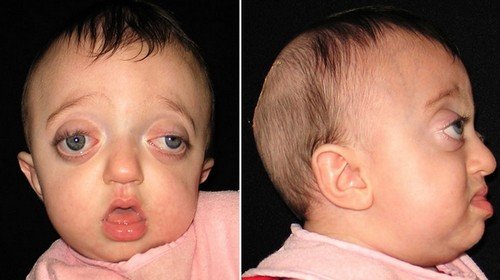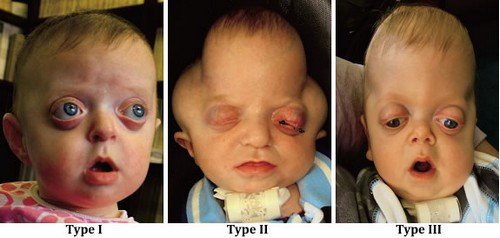Pfeiffer Syndrome
What is a Pfeiffer syndrome?
It is a genetic disorder causing premature fusion of some bones of the skull. As a result, the skull fails to grow normally leading to a distorted shape of the head and face. Pfeiffer syndrome does not only affect the bones of the skull, but also the bones of the hands and feet.
There are three subtypes of Pfeiffer syndrome. They are:
- Pfeiffer syndrome type I (classic Pfeiffer syndrome) – Patients have normal intelligence and a normal lifespan but have the typical manifestations of the disease. The patient has craniosynostosis causing the head to look elongated vertically. The patient has a high forehead, wide spaced eyes, underdeveloped mid-facial regions, underdeveloped upper jaw, dental abnormalities, and prominent lower jaw. (1, 2)
- Pfeiffer syndrome type II – Type II has severe craniosynostosis. The abnormalities in the hands and feet are severe and there is also malformation of the limb. The skull appears tri-lobed in appearance (cloverleaf skull deformity). There is a severe protrusion of the eyes, broad forehead, low set ears, beak shaped nose, and rare cases of visceral anomalies (abnormalities in the internal organ). Patients have intellectual disabilities and neurologic problems. Eventually, patients could experience life threatening complications if proper treatment are not given. (3)
- Pfeiffer syndrome type III – It is a severe forms of Pfeiffer syndrome and usually affects the nervous system. Patients with this type of Pfeiffer syndrome have delayed brain development and other neurological abnormalities. It also has bone fusion in the elbows and other joints in the body. As a result, patient’s mobility is limited and experience abnormalities on the face and airways. Clinical manifestations of type III Pfeiffer syndrome include a shortened base of the skull, ocular proptosis, presence of teeth at birth (natal teeth), and visceral anomalies. Patients also have severe neurological problems and intellectual disabilities. (4, 5)
Pfeiffer syndrome Images

Image 2: An eight month old child with Pfeiffer syndrome
Picture Source: www.chop.edu

Photo 2: The different types of Pfeiffer syndrome
Picture Source: drugsdetails.com
The typical symptoms of Pfeiffer syndrome include the following:
- Bulging of the eyes
- Wide set eyes
- Underdeveloped upper jaw
- High forehead
- Beaked nose
- Dental problems
- Hearing loss
- The thumbs and big toes are wide and bend away from other digits
- Brachydactyly (short fingers and toes)
- Syndactyly (fusion/webbing between the digits) (6)
Pfeiffer disease is known in other names such as ACS V, Noack syndrome, craniofacial skeletal dermatologic dysplasia, and acrocephalosyndactyly. (6, 7)
Cause of Pfeiffer syndrome
Pfeiffer syndrome is a result of a glitch in the genes that control the growth of certain cells. This condition is hereditary, which means that it can be passed on from a parent to a child. There are also instances wherein the parents don’t have the syndrome but the baby still has it.
Most cases of Pfeiffer syndrome type II and III originate from new mutations (FGFR2 mutation). Type one is linked with gene mutation FGFR1 and FGFR2. (10)
How is Pfeiffer syndrome diagnosed?
The doctor will conduct a thorough physical examination to check for signs and symptoms of Pfeiffer syndrome. The doctor will examine the skull, thumbs, and big toes. The doctor will also order additional test to confirm the patient’s diagnosis.
- Imaging studies like X-ray and CT scan.
- Genetic testing
- Laboratory test (6, 7, 8)
Pfeiffer Syndrome Treatment
The treatment of choice for patients with Pfeiffer syndrome is surgery. The site of surgery primarily depends on the affected parts of the body.
- Skull surgery – Surgery is required to reshape the skull. This is done before the child turn 18 months old. If the patient is under three months old, a small opening in the head is created. For older patients, the doctor uses traditional surgery. Over the course of the patient’s lives, he/she needs two to four surgeries of the skull. (9)
- Mid-face surgery – Some patients need to correct deformities in the jaw. Before this surgery is done, make sure that the children is at least 6 years old.
- Correcting breathing problems – Some patients experience blockage, which affects their breathing. It could lead to a condition called sleep apnea. There are a variety of techniques to correct this problem such as wearing a special mask while sleeping (CPAP), continuous positive airway pressure. The blockage can be removed with the help of mid-face surgery. What the doctors will do is to remove the tonsils or adenoids. For severe cases, the doctor will perform tracheostomy. It is a procedure wherein the doctor will create an opening in the neck of the patient to ease the breathing. (1, 2, 5)
- Other treatment approach includes dental work to address issues like out of position teeth and underbite, surgery of the fingers and toes, and therapy to correct the speech and language difficulty.
What is Pfeiffer syndrome life expectancy?
What is Pfeiffer syndrome prognosis? What is the life expectancy of people with Pfeiffer disease? Those with Pfeifer syndrome type 1 usually live a normal life and life span. Unfortunately, those with Pfeiffer syndrome type II and III have the high chance of developing complications, which could shorten their life expectancy. (1, 10)
Pfeiffer syndrome is named after Rudolf Arthur Pfeiffer. He described eight people in three generations of family who has acrocephalosyndactylia (abnormalities of the head, hands, and feet). It is a condition that is inherited in an autosomal dominant pattern. It affects one out of 100, 000 babies.
It is caused by mutation in one of two genes that are responsible in the bone development of an infant. It causes speed up in bone production leading to premature fusion of bone in the skull. Treatment and management for Pfeiffer syndrome primarily depend on the severity of the condition. If proper treatment, care, and management is given to the patient, he/she could have a positive prognosis, although type II and type III Pfeiffer syndrome is extremely difficult to treat. (6, 7, 9)
References:
- https://ghr.nlm.nih.gov
- www.medicinenet.com
- https://en.wikipedia.org
- https://rarediseases.org
- www.faces-cranio.org
- www.webmd.com
- www.health.com
- www.seattlechildrens.org
- www.ccakids.com
- Management of Genetic Syndromes By Suzanne B. Cassidy, Judith E. Allanson